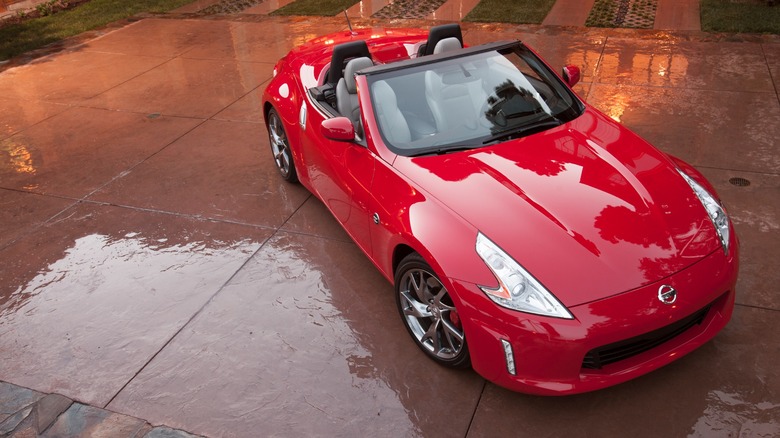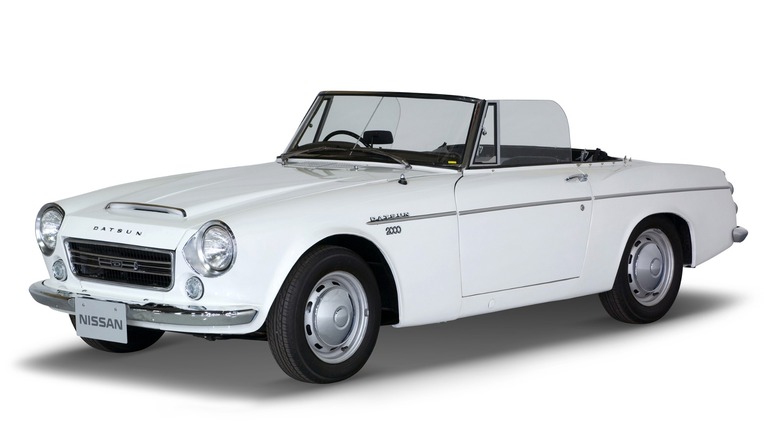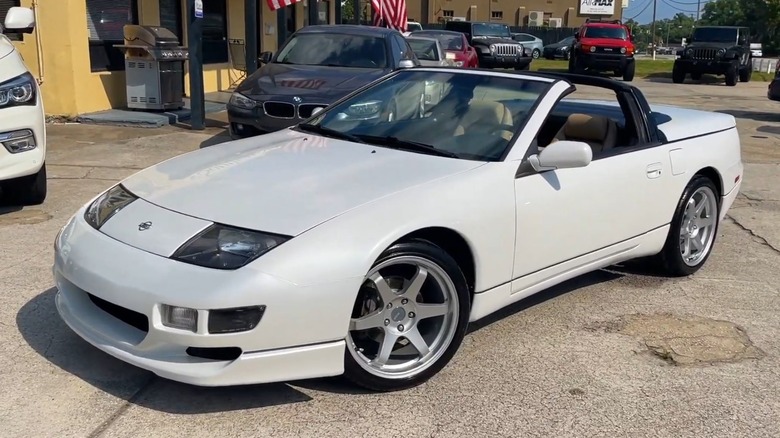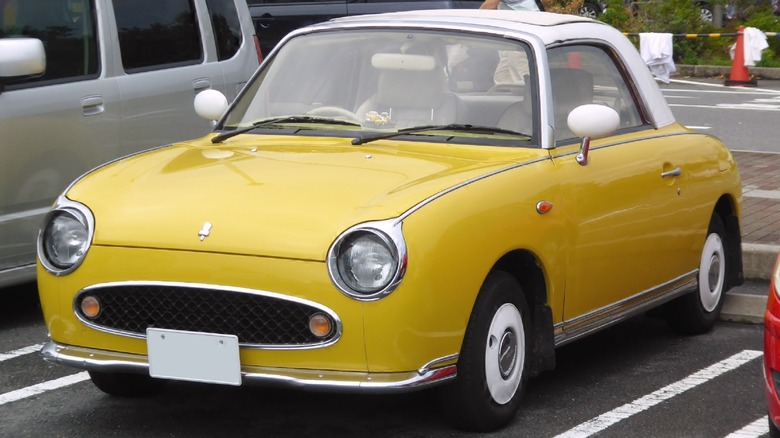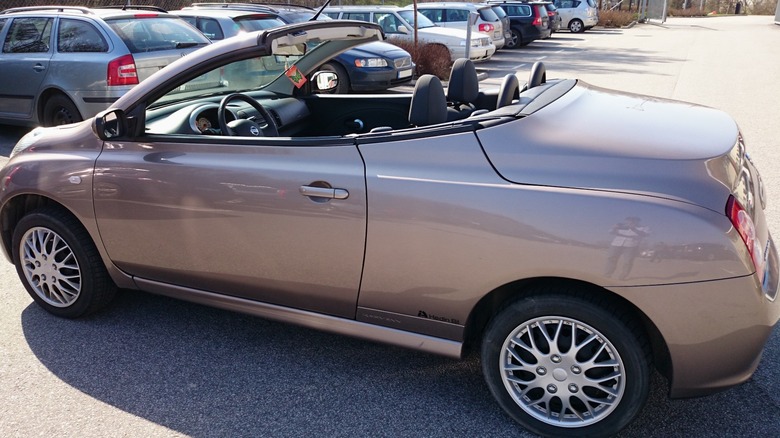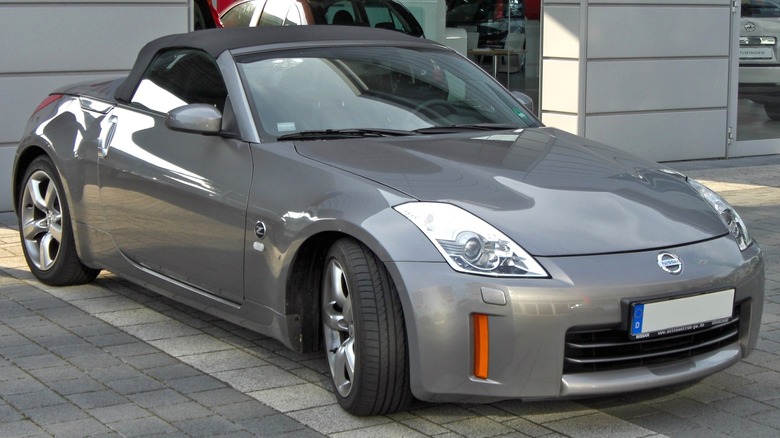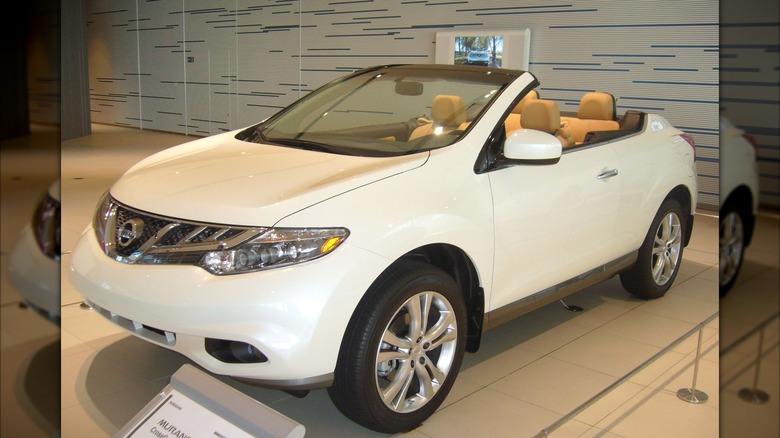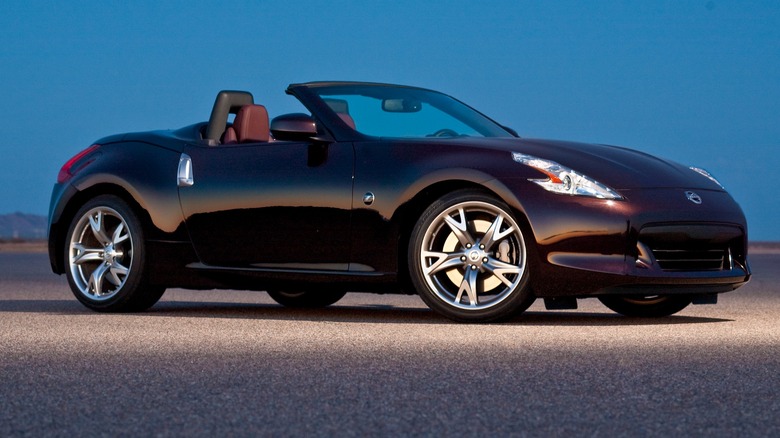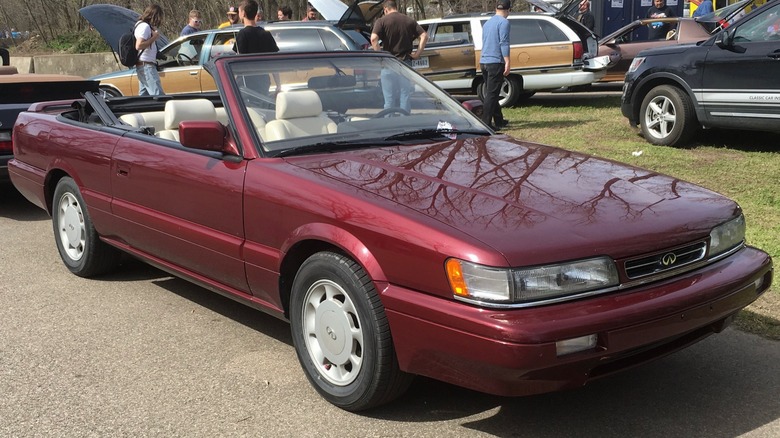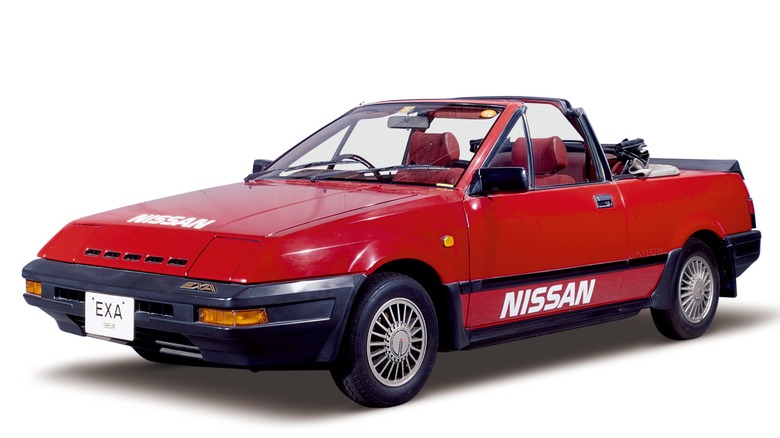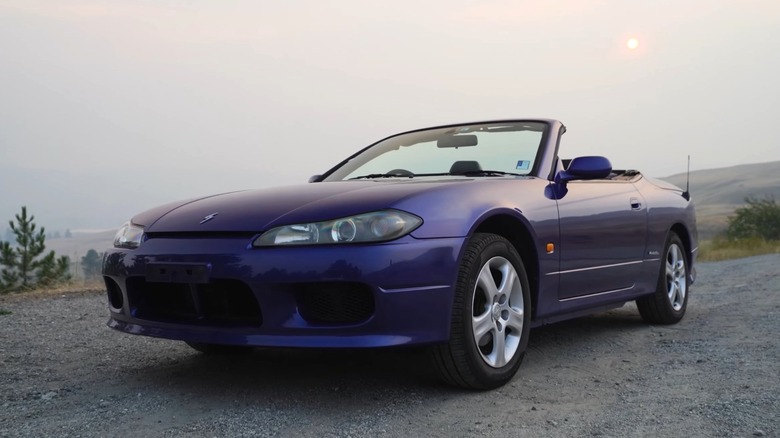Every Nissan Convertible Ever Made
When you think of convertibles, Nissan likely isn't the first name that comes to mind. For most, the brand is more associated with ultra-reasonable family cars like the 2025 Nissan Altima or legendary performance cars like the Nissan GT-R. Despite that, the Japanese automaker is no stranger to offering its customers the chance to get some wind in their hair.
Sure, you're probably familiar with the Roadster versions of the 350Z and 370Z, but there's so much more to Nissan's convertible products than just those two. Granted, it's still not a huge selection, but products like the early Datsun Fairlady roadsters, the quirky Nissan Figaro, and the much-maligned Nissan Murano Crosscabriolet all show that Nissan has form here. Not all of these products were necessarily great (or successful), but you can't blame Nissan for trying — even if we still can't quite figure out what it was thinking with the Murano Crosscabriolet. But we'll discuss that vehicle when the time comes.
As of early 2025, Nissan's vehicle lineup is entirely free of convertibles, with no signs that's going to change any time soon. But even if the company never makes another droptop, that's no reason not to take a trip down memory lane and check out all of the convertibles it's built over the decades.
Datsun Sports/Fairlady
We'll kick things off with the grand-daddy of not just Nissan convertibles, but arguably also of the Japanese automaker's iconic Z cars: the Datsun Sports roadster — also known as the Fairlady in Japan. The first model was the Datsun 1000 Sports roadster in 1959, a plastic-bodied 37 hp convertible. Nissan allegedly made only 20 units of it, all right-hand-drive.
Things got a bit more serious with the follow-up. The 1200 Sports was the first of the company's Sports roadsters to come to the U.S., with the first shipments of the left-hand-drive SPL212 beginning in January 1960, and October of that year saw Nissan introduce a revised version of the 1200 codenamed the SPL213. The main difference was a slightly more powerful inline-four engine capable of 54 hp and 64 lb-ft of torque.
However, the second-generation Fairlady models truly gave birth to Nissan's lineage of sports cars. The 78 hp Fairlady 1500 competed in Japan's first-ever GP race in 1963, with driver G. Tahara piloting the two-seater to first place in the B-II category. and the company would follow this up with two more Fairlady models: the Fairlady 1600 and Fairlady 2000. The latter had a two-liter inline-four capable of 143 hp and 130 lb-ft of torque, which Nissan claims was good enough for a 127 mph top speed. Nissan retained the Fairlady name for the Japanese version of the 1970 Datsun 240Z, but it would be quite a few years before we'd see another roadster in the family tree.
Nissan 300ZX Convertible
Drop-tops wouldn't feature as an option on Nissan's Z-cars for quite a few decades after the Fairlady 2000, with the 240Z (and variants), 280ZX, and first-generation 300ZX Z31 all sticking with coupe body shapes. But that would change with the Z32 300ZX, one of the greatest JDM cars of the 1990s.
The Z32 debuted in 1989 as a clean-sheet design, despite sharing the same nameplate as its Z31 predecessor. Almost everything was new: The Z32 had softer lines than the angular Z31, with revised suspension and handling making it a significant cut above the somewhat unloved Z31. 300ZX. Nissan also offered two new engines: a 222 hp 3.0-liter V6 and a twin-turbo version with 300 hp that came a bit later to the U.S.that also added four-wheel steering. The Z32 was something of a triumph, with contemporary reviews celebrating the new Z's styling, handling, and performance.
Z32 owners could enjoy an open-top experience from the get-go, with Nissan offering a Targa-top version of the couple starting with the first model year in 1990. The company went one step further in 1992, making a proper convertible version — with a manual top — available for Japanese and North American buyers. The lack of a turbo option and roughly $40,000 price probably stymied Nissan's hopes of the convertible Z32 succeeding, though. The coupe sold reasonably well, but the company allegedly sold fewer than 4,000 convertibles in the U.S. and Canada.
Nissan Figaro
We have two more convertible Nissan Zs to discuss, but let's take a break from that lineage to discuss one of Nissan's more unique detours of the 1980s, the Nissan Figaro. Arguably one of the strangest cars Nissan ever made, the Figaro was one of four so-called "Pike cars" — all based on the Nissan March — that came out of the automaker's Pike Factory in the 1980s and early 1990s, the others being the Be-1, Pao, and S-Cargo commercial van.
All four were cute and quirky, with postmodern retro-futuristic styling that made them instant hits. The Be-1, the first of the four, came out in 1985 in a limited run of 10,000 units and proved so popular that the company had to implement a lottery system to handle pre-orders. The Pao and S-Cargo followed in 1989, with the Figaro hot on their tails, debuting in 1991.
The Figaro was undeniably the most retro-minded of them all, drawing inspiration from 1935's Datsun Roadster. Designer Jun Shimizu told Road & Track he focused on the image of "a 19th-century woman sitting in the car, with a parasol" when conceptualizing it. The result was an art-deco fixed-roof convertible that continues to look amazing today, with styling that's both undeniably retro yet strangely modern.
Nissan built just 20,000 units of the Figaro. As with its predecessors, the tiny Pike Factory product sold out completely in the pre-order phase.
Nissan Micra C C
Nissan's Figaro wasn't the only time it would bring a convertible top to a March (better known as the Micra in non-Japanese markets) platform. The company repeated the trick when it introduced the Micra C+C in 2005, dropping the rear doors and replacing the metal roof with a folding glass offering built and designed by Karmann. Yes, the same Karmann that worked on the classic Volkswagen Karmann Ghia.
Nissan's designers put more effort into the C+C than just swapping the roof out, too. The Micra C+C's body was slightly longer, with an angled windshield that dropped the roof line by nearly 4 inches. It still wasn't necessarily the prettiest cabriolet out there, but the adjustments made to the Micra's lines did at least give it a bit more poise.
While the Micra C+C is likely remembered — rightly or wrongly — for Richard Hammond's infamous review on "Top Gear," the C+C was a decent, if not necessarily amazing car. Top Gear magazine was initially more appreciative of the C+C, noting that it competed well against its rivals (although it later revised its opinion in 2013, naming it one of the worst cars of the past 20 years). Other contemporary reviews were also quite positive, especially for its top-of-the-line Essenza trim, which came with the 108 hp engine from the Micra 160 SR. Nissan dropped the convertible body for the next-generation Micra in 2010 and has stuck to the five-door hatchback body since.
Nissan 350Z Roadster
The late 1990s and early 2000s were barren times for fans of Nissan's Z-car, at least in the U.S.: the company withdrew from the market at the end of 1996 and stayed away for a handful of years, with the only hint of a comeback being the Nissan Z Concept it showed at the 1999 North American International Auto Show.
And while the Z Concept allegedly didn't directly lead to the 350Z, it's impossible to deny that the Z's eventual 2003 comeback owed more than a little to the Z Concept, sharing its hatchback coupe body shape and general styling cues. And while it had been four years since the concept, the wait looks to have been worth it: The 350Z made a splash when it debuted, earning plaudits from the motoring press for its performance, handling, and excellent value.
Nissan was onto a winner, then, and it looked like the Z was back where it belonged — an impression that Nissan reinforced when it introduced the 350Z Roadster for the 2004 model year. The 350Z Roadster sported a powered soft top with a glass rear window and, unlike the Z32 convertible, managed to avoid having a large rear hoop ruin its sleek lines with the top down. The Roadster's folding top added a bit of weight to the 350Z, but the 287 hp VQ35DE engine was seemingly capable enough to handle the extra load. The 350Z Roadster was available until 2009, with the final model year selling alongside the 2009 370Z hardtop.
Nissan Murano Crosscabriolet
It's time to discuss a vehicle that's arguably one of the greatest automotive missteps ever: the Nissan Murano Crosscabriolet. The Crosscabriolet is one of those exceedingly rare examples of a convertible SUV, occupying the same strange market as offerings like the Range Rover Evoque Convertible and Volkswagen T-Roc Cabriolet — although at a much lower price point.
Despite the Murano Crosscabriolet's terrible reputation, it's worth remembering that the Murano itself was reasonably well-received when it debuted for the 2003 model year. Reviewers liked its combination of SUV practicality and relatively sporty performance, and so did buyers: Nissan sold nearly 75,000 Muranos in 2005, with sales numbers staying relatively consistent for the better part of two decades. None of which explains the Murano Crosscabriolet's existence, of course.
But the drop-top crossover was never really a logical decision, with most of the credit (or blame) for it landing at the feet of now-disgraced Nissan CEO Carlos Ghosn. The Crosscabriolet wasn't a simple undertaking, either: The SUV was almost entirely new, with everything behind the firewall having to be redesigned. Interestingly, contemporary perspectives weren't totally hostile, with some journalists appreciating the high-quality interior and comfortable ride. One MotorTrend writer did call it "the most stupid vehicle of 2011," though.
Nissan only sold 6,000 Murano Crosscabriolets, although its unpopularity now makes it a hot commodity: A few low-mileage units have recently sold for around $20,000, proving there's a market for just about anything.
Nissan 370Z Roadster
Let's return to some semblance of normalcy now by looking at the final drop-top Z-car Nissan ever built as of the time of writing, the 370Z Roadster. The 370Z Roadster first broke cover in 2009 before debuting for the 2010 model year, a year after Nissan had introduced the hardtop 370Z to replace the 350Z.
The 370Z coupe wasn't revolutionary, but its new 332 hp V6 engine, revised suspension, a shorter wheelbase, and slightly lower curb weight were definite improvements over the dated 350Z. Nissan also brought the 350Z's lines into the modern day with a sharper look, while an improved interior and new electronic aids kept Nissan's sports car offering competitive with rivals. One notable highlight of the 370Z was a feature called SynchroRev Match, available only on manual 370Zs. SynchroRev Match blipped the throttle on downshifts, maintaining engine speed when dropping gears without requiring the driver to perform heel-and-toe shifts.
All of these improvements carried over to the 370Z Roadster, which stuck to the 350Z's soft top but opted for a classier cloth material compared to the old vinyl top. Nissan's 370Z redesign extended to the Roadster's soft top, too, which now had a more sloping rear that better resembled the hardtop's roof line. We think the coupe still looked the better of the two, but the 370Z Roadster wasn't as big of a downgrade as the 350Z Roadster had been. Nissan discontinued the 370Z Roadster in 2019 and ceased production of it outright the following year.
Infiniti M30 convertible
Depending on how strict you want to be, this may or may not count as a Nissan convertible. But given that we've discussed a few early Datsuns and the fact that the Infiniti M30 was essentially a rebadged Nissan Leopard marketed via the upmarket Infiniti division, we think it's worth discussing for the sake of completion.
The Infiniti M30 was one of two vehicles Infiniti offered on its 1989 U.S. debut, the other being the Q45. The latter was an all-new product, aiming high and broadly succeeding thanks to its 278 hp and BMW-rivaling luxury. The M30, on the other hand, wasn't quite so hot, not least due to its dated looks and mundane 162 hp engine under the hood. But it wasn't necessarily a bad car, and more recent retrospectives have cast the M30's restrained luxury and effortless driving experience in a much more positive light.
Nissan decided to shake things up for 1991 by offering a drop-top version of the M30. Interestingly, this convertible M30 wasn't an in-house Nissan product. Instead, all M30s left Nissan's Japanese factories as hardtop coupes, with American company ASC handling the soft-top conversion once units hit the U.S. This had an obvious knock-on effect on chassis rigidity, but that was perhaps less of a pressing issue on a slow cruiser. The convertible M30 didn't prove that much more popular, though, and Infiniti discontinued the M30 in 1992.
Nissan Pulsar EXA Convertible
We've covered the most obvious Nissan convertibles, but we're not quite done yet. There are a couple more Japan-only examples, and we'll start with the more mundane — but no less pleasing — of the two. The Nissan Pulsar EXA Convertible was an ultra-limited soft top version of the Pulsar EXA (or Pulsar NX in the U.S.), which was itself a sporty, two-door version of the otherwise mundane Nissan Pulsar (or Nissan Cherry, depending on locale).
Nissan offered several engines in the Pulsar EXA: The 1983 U.S. model debuted with a 70 hp 1.6-liter but eventually received a much sportier turbocharged E15T 1.5-liter engine making 113 hp — the latter also available in the Japanese-market Nissan Sunny Leprix Turbo. But the Pulsar EXA Convertible had neither of these engines, with the limited-edition drop-top sporting the 1.5-liter E15 engine, presumably a non-turbocharged version of the U.S.-market EXA's E15T. This naturally aspirated engine wasn't quite as weak as the 1.6-liter, but its 84 hp and 89 lb-ft of torque certainly wasn't impressive.
So the EXA Convertible wasn't sporty, then, but that probably wasn't the point: Nissan only made 100 EXA Convertibles, all to celebrate the 15th anniversary of its Nissan Cherry dealership network in Japan. The EXA Convertible is probably the rarest version of the Pulsar EXA, but it's arguably not the coolest: the second-generation EXA Sportbak takes that cake with its glorious — and eminently practical — shooting brake rear canopy.
Nissan Silvia Varietta
Finally, we come to what we think is the most desirable Nissan drop-top on this list. It's not the rarest, but those of you who have a combined love for roadsters and JDM heroes will likely agree that it's the most notable of the bunch. Say hello to the Nissan Silvia Varietta, a retractable hardtop version of the classic seventh-generation Nissan Silvia.
Yes, you read that right: Nissan offered a convertible S15 to Japanese customers, with the convertible conversion handled by one-time Nissan subsidiary Autech — now part of Nissan Motorsports & Customizing, having been merged with Nismo in 2022. The Silvia Varietta was one of three Autech Silvia S15s and was unfortunately the least powerful of the bunch, with the cabriolet sporting the Silvia Spec S' naturally-aspirated, 165 hp SR20DE under the hood. So, no, you're not getting the full-on SR20DET experience in a drop-top, but we're guessing that the Varietta was more about looking good than going fast.
Of course, since it's an S15, nothing's stopping you from swapping in an SR20DET if you manage to get your hands on a Silvia Varietta. Unfortunately, that's probably going prove very tough: Nissan only ever sold around 1,100 units — some sources say 1,120, while others claim 1,143 — so they're exceedingly rare. But hey, there are few better ways to get some S15 action in your life and stand out from the JDM crowd at the same time.
